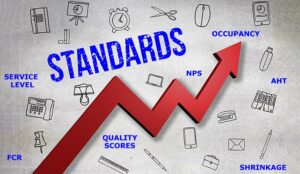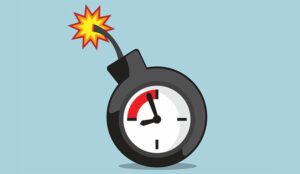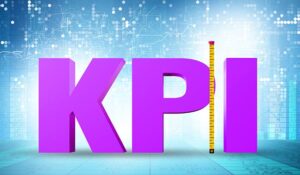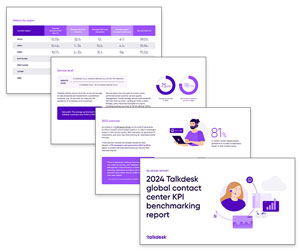Dorottya Márton of VCC Live shares eight contact centre key performance indicators (KPIs), sharing industry averages for each.
Measuring and understanding the KPIs of your contact centre is essential for understanding its effectiveness.
KPIs can let you know where to concentrate your customer service efforts and can help you plan your next business decision.
Most contact centre managers understand that they need to constantly oversee their operation’s KPIs and metrics.
However, it might not always be clear what KPIs agents should focus on and what industry standard they can expect from their team’s performance.
This guide looks at the top eight contact centre KPIs along with their global industry standards.
With this guide, you can make sure to put yourself on the right track towards excellent customer service!
1. Service Level
If you are running inbound operations in any form, this is your top contact centre KPI to track, as it indicates whether you have enough agents to resolve your customers’ needs.
Service Level helps your contact centre estimate the percentage of calls answered within a specific amount of time.
Usually, the industry standard for this amount is known to be 20 seconds and the common goal is to have 80% of your incoming calls answered by an agent.
However, it is important to note that this standard should be taken flexibly. Call volumes vary based on the specific company’s size, growth rate, and its number of customers.
Do some research on your audience and make sure to consider factors such as customer needs, expectations, and priorities before setting your Service Level objectives.
2. Average Speed of Answer
Not to be confused with Service Level, the average speed of answer (ASA) is the average amount of time it takes for calls to be answered, in seconds.
Even when reaching the target Service Level, it is possible for calls to spend a lot of time in queue, depending on the various metrics of your business.
Therefore, it is important to complement Service Level with ASA, as it represents the experience of individual callers.
Seen as an indicator for customer satisfaction and your operation’s overall performance, the industry standard for this contact centre KPI is 28 seconds.
Having a longer ASA could be an indicator of weak customer satisfaction and can leave open the potential for agent burnout.
3. Average Handling Time
Like its name suggests, Average Handling Time (AHT) is the amount of time it takes for your operation to handle a call, starting from the initiation of the call (inbound or out), to its final resolution, including hold time and talk time.
Most contact centres aim to reduce this time to as little as possible, making up an industry standard of 6 minutes.
However, just like with Service Level, this contact centre KPI should be taken flexibly, as it can vary based on the specifics of your company, such as its scale and size, as well as on the sector you are in.
4. First Call Resolution
Similarly to Average Speed of Answer, this contact centre KPI can be used to measure the experience of individual calls.
First Call Resolution (FCR) measures the percentage of calls resolved by your agents on first interaction with the caller. This means that no follow-up call or further interaction is required to solve the issue at hand. The general industry standard for this KPI is set at 70-75%.
5. Average Abandonment Rate
Average Abandonment Rate (AAR) measures the percentage of calls disconnected by customers before reaching an agent. This contact centre KPI is generally seen as an indicator of how your clients relate to wait queues and it can be an indirect indicator of your general customer satisfaction.
According to a study conducted by American Express, 67% of customers hang up the phone because they cannot get through to a live agent.
The general standard for this KPI varies between 5 and 8% and can reach up to 20% based on variables such as the time of day.
6. Wrap Up Time
Call Wrap Up Time, or After Call Work refers to the amount of time an agent spends on tasks after the call has been finished with the client. This includes follow-up tasks related to the call, such as setting a call-back time, filling out CRM forms and resolving potential issues with their manager.
The industry standard for this metric can vary, depending on the industry you are in.
Additionally, the more complex the call, the longer you can expect your wrap up time to be.
While the global metric for this contact centre KPI is set at 6 minutes, it is important to note the differences in industries.
Wrap up time in tech support can be expected to be much longer than in retail for example.
7. Maximum Occupancy
Maximum Occupancy refers to the amount of time that agents work on call-related activities. This includes talk, hold, and wrap up time.
The general industry standard for this contact centre KPI is 60-80%.
Higher rates than this mean that your agents have no or very little time between calls, leading to agent burnout and high employee turnover.
8. Net Promoter Score
Net promoter score (NPS) measures customer loyalty to your brand or service.
Measured on a 1-10 scale, customers are usually asked the following question after the call: “How likely is it that you would recommend a service to an acquaintance?”
The clients are then grouped into: promoters (score of 9 or 10; satisfied and would recommend your business to others), passives (score of 7 to 8; overall satisfied, but do not promote your brand), or detractors (0 to 6; not satisfied with your services).
Reported on a scale from -100 to +100. The median global industry standard for this KPI is +44. This means that half of companies score below and half score above this rate.
25% of the lowest performers have an NPS score of 0 or lower and 25% of the best performers have a score of 72 or higher.
If your company scores below zero, you should start thinking about re-planning your customer care strategy.
This list is essential whether you are just starting out your business and newly planning your customer care strategy, or already have your operations up and running.
Keeping the most essential contact centre KPIs in mind is essential for the planning and maintenance of any operation dealing with customer service.
While these industry standards can vary based on the specifics of your industry and operations, they can be a good indicator of what to look out for when managing your contact centre!
Author: VCC Live
Published On: 1st Mar 2021 - Last modified: 26th Feb 2025
Read more about - Archived Content, Key Performance Indicators (KPIs), VCC Live
















